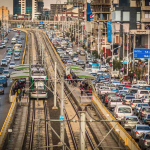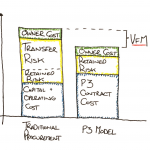Trends that have been observed by the scientific world for decades show that when populations grow unregulated by opposing forces, the given population will eventually reach its environmental carrying capacity (Daily & Elrich, 1992). Carrying capacity is the limit to which a given environment can support the species for which it provides habitat. If carrying capacity is breached, dramatic events such as, population crash and irreversible environmental degradation usually occur. Although many believe that this observation can be directly applied to the human race, there are others who argue that the way to decrease environmental degradation is to increase economic growth. The proponents of the latter point of view can support their argument with the “strong correlation between incomes, and the extent to which environmental protection measures are adopted” (Panayotou, 2003). However it has also been observed over modern human history that as agricultural and industrial production increase, environmental disruption and degradation increase as well (Panayotou, 2003). In either case, the relationship between environmental degradation and economic growth is complex, and unique to local socio-economic and environmental conditions. The examples above demonstrate only a few of the many issues that are involved in the intricate web of ties between national economies and the natural environment.
Traditionally, the relationship between environmental degradation and economic growth has been described by the use of the Environmental Kuznets curve. This common representation shows environmental degradation increasing with economic growth to a point at which environmental quality begins to improve. There are several downsides of such a broad projection, one being the high level of assumption as well as a lack in accounting for stochasticity of local scenarios. The Kuznets curve also lacks the ability to accurately account for long term impacts of environmental costs such as waste build-ups and widely dispersed pollutants (CO2) (Arrow & Bolin, 1995). The Kuznets curve also fails to account for the counter-effects of reducing negative environmental influences such as pollution. Often when pollution is reduced in one area, the effects of pollution in other related areas are increased, thus cancelling out the effort (Arrow & Bolin, 1995). The shortcomings of the Kuznets curve serve to show the difficulty in analysing complex global issues, and furthermore the difficulty that lies in crafting solutions for such problems.
In the past there have been many attempts to mitigate the environmental consequences of unconstrained (economic and population) growth. Many of the attempts in recent times have worked to retool domestic and international economies so as to incorporate ecological and social goals into the production function. During this time there has been a series of waves that work to investigate new ways of approaching the state-environment relationship, what While, Jonas, & Gibbs, (2009) define as Eco-State Restructuring (ESR). It is the re-organisation of state powers, regulations, instruments, institutions, etc in an attempt to reduce the environmentally damaging effects that the previous path caused or failed to adequately address. Within the ESR history, there have been eras of restructuring (While et al, 2009; Hessing, Howlett & Summerville, 2005), which have worked to pull governance leftward on a “spectrum of environmental ideas” (Hessing et al., 2005, p. 8), from a resource oriented framework to a concept of resource management.
Hessing et al. (2005) propose four eras of policy formation in Canada that reflect different objectives during different time periods: the first era of government inaction was defined during the pre-1800 period, a time of resource exploitation. The second period occurred between 1800 and 1880 and was an era of revenue generation wherein claiming royalties from natural resources ranked highest on government agendas. The third era occurred between 1880 and 1950 in which a conservation ethic was borne. The final era of policy formation, beginning in the 1950s and continuing today, has been deemed the management era, in which efforts have been made to ensure long-term resource sustainability (Hessing et al. 2005).
Based on the work by While et al. (2009) we have taken a more recent look at this trend and have approached the concept through a global lens, offering a different view wherein three major era’s of environmental policy formation can be identified. The first era of conservation and pollution control began in the 1960’s and lasted until the mid 1980’s, in which time a switch to a new model based on sustainable development was initiated. The sustainable development era began in the mid 1980’s, but it was retooled during the mid 1990’s, marking the beginning of the current era of market-based management and carbon control (see appendix 1). In the following pages my colleague and I will discuss the cause of this wave-like trend and how it occurs, we will look at the effects that each era has had on the economic and environmental landscape, and we will offer some possible solutions to the continuing problems that have been carried through to each new era, but have been inadequately addressed so far.
The Wake of Externalities
To visualize this process it is helpful to use an analogy of a tanker ship sailing around the globe. Her name is Capitalism, she is a strong vessel (powered by fossil fuels), and as she pushes through the water a wake emanates out behind that affects much more area than that immediately beneath her hull. In this sense, the waves created by the wake can be thought of as the negative externalities of production, and as the waves ripple out the distance between them increases. In this sense, the wake is the effect that the ship has on the environmental and social landscapes (a larger wake creates larger disturbances on the landscape). We will assume that the wake is influenced by several factors such as the shape of the hull (the hydrodynamics), the weight of the ship and the distribution of that weight, its speed, and the surface roughness of the water body.
Wake = ( Hull Shape + Displacement + Speed )
Seascape
Hull Shape
The size of a wake is largely a product of the hydrodynamics of the vessel, similar to the aerodynamics of other vehicles. By modifying the shape of the hull the wake can be reduced. Relating back to our ESR analysis, this strategy is often pursued through policy formation that works to modify the shape of the economy to better align it with environmental and social objectives. Often referred to as ecological modernization, this approach “involves a collection of ideas about retooling modern societies and economies to achieve a more sustainable relationship with the environment and ecosystems without compromising the quality of life delivered by industrial economies” (Harper & Fletcher, 2008, p. 333).
Displacement
As the weight of a ship increases it sinks lower beneath the surface and displaces a larger volume of water, thus creating a larger wake. This displacement is analogous to a growing global population with a growing global GDP. The typical policy response calls for mitigation strategies to reduce the load that our economy is carrying; it’s through this strategy that eco-state restructuring has been applied, by modifying the economy through mitigatory strategies and technologies to reduce the externalities of production and consumption. The neo-Malthusian perspective, held by many mainstream economists and demographers, maintains that population growth is one of the most, (if not the most) significant causes of social and environmental degradation, and it is through this lens that the above mentioned concept of a global carrying capacity most strongly relates (Harper & Fletcher, 2008).
The distribution of weight is also a factor that affects the size of the wake. If the weight is allocated evenly over the hull then the wake can be reduced, but if the weight is disproportionately distributed (to the rear for example), then the wake becomes much larger. This factor can be related to the growing income inequalities of the global north and south, and to the relationship between the rate of population growth in the developing countries and the rate of environmental and social degradation (Stern, 2004), as expressed by the environmental Kuznets curve mentioned above (see figure 1).
Speed
The effect of speed can be rather elusive, as small craft are able to reduce their wake as their speed increases due to the reduced surface area of contact with the water. This effect does not however, relate to large vessels carrying heavy cargo. In our analogy, the speed of the ship symbolizes the momentum of the economy and the path dependence that is associated with democratic policy formation. Path dependence dictates that as developing countries close the inequality gap and move toward becoming a developed nation, they increasingly rely on technologies and strategies that were adopted in those developed countries which infer a sequential, predetermined path to development (Goodstein, 1995). This ignores the possibility of alternative methods of development which may be more efficient or better suited for those nations. Further, the policy process of most countries is often slow or ineffective at creating effective environmental policies, because policy makers are prone to making decisions based on short-term objectives due to the election process and their desire for re-election (Harper & Fletcher, 2008).
One way to modify a ship to eliminate the wake is to simply throw out an anchor and kill the engines, otherwise known as a steady-state economy. Tim Jackson defines a steady-state economy as a system in which “stability no longer relies on ever-increasing consumption growth… One in which our capabilities to flourish – within ecological limits – become the guiding principle for design and the key criterion for success” (Jackson, 2009, p. 43).
Seascape
The surface roughness of a water body can hide the size of wake being produced as rough seas can overcome the waves created by the ship; but the depth of the sea also plays a role, as waves become larger as the depth decreases. In this respect, waves generated from the wake are only noticed long after they have been created and become increasingly significant as they near the shore. This is akin to the market environment and the boom-bust fluctuations of recessionary and inflationary periods, which either float the boat higher (Inflationary) or cause it to run aground (as in a depression). A recession is less devastating to the ship, but potentially more devastating to the social and environmental landscapes because it causes turbulent seas that work to distract the public attention away from the effects the ship is causing, by shaking the boat around and causing the vessel to slow down.
Riding the Waves
As each successive wave crashes onto the shore a new urgency is realized, and beginning in the late 60’s the people standing on the shore began considering ways to combat and reduce the effects of the waves created by the wake of Capitalism. They tried to rework the shape of the vessel to streamline it and reduce the wake it generates, but each successive attempt to re-engineer the ship has been time-intensive and (so far), ineffective.
Beginning in the 1950’s the ship began adding weight and gaining speed, and by the early 1970’s the waves hitting shore began generating concern which marked the pinnacle of the Conservation and Pollution Control Era (see appendix 1). Spanning two and a half decades, the conservation and pollution control era marked the inception of Environmental Justice movements and provided the foundation for the Deep Ecology environmentalism of the 1980`s (Harper & Fletcher, 2008).
As the externalities of Capitalism continued to roll onto shore (and with increasing magnitude), it was clear that the existing mitigation strategies were not enough. The waves that hit shore during the 1980’s were larger and more global in scope, so the urgency and effort to combat these effects expanded and new movements were created to coordinate the restructuring process. The mid 1980`s marked a transition to the Sustainable Development Era (see appendix 1), which John Robinson defines as “an attempt to bridge the gap between environmental concerns about the increasingly evident ecological consequences of human activities and socio-political concerns about human development issues” (Robinson, 2004). This transition to sustainable development was propelled by the outcomes of the Brundtland Commission’s Our Common Future, which attempted to address the displacement effect by modifying the hull shape, so as not to reduce the speed of the ship. The Brundtland report suggested that the answer to both environmental and social problems could be ascertained by encouraging more human development that would respond to environmental limits – sustainable development.
But the ship continued on. In recent times the externalities of capitalism continue to reach our shores, and again we have developed new methods to streamline the ship. This time we have opted to drastically reconfigure the nature of the vessel to incorporate the wake into its production function, relying heavily on the development of technology and market-based policy tools. Through agreements stemming from the Kyoto Protocol’s flexible mechanisms, market-based management tools are beginning to incorporate the externalities of capitalism into the inner workings of the machine, “assum[ing] that the way to protect the environment is to price nature’s services, assign property rights, and trade these services within a global market” (Bumpus & Liverman, 2008).
What does it Mean?
By using this rationale we can calculate a cause and effect relationship, which helps uncover the root of the problem. It seems that the reason these waves of environmental governance continually fail is not that the concepts themselves won’t work, but that they can’t work because they oppose the foundations of capitalism, and that they are only partial fixes (or patches) which fail to account for all of the variables of the equation. In reference to the analogy above, the process of eco-state restructuring is like trying to build a boat that creates no wake, and it would appear that there are two possible ways of building a wake free vessel.
The first way is to completely redesign the vessel so that it leaves the surface water undisturbed. For example, the vessel could ride above the surface on a hovercraft or below it in a submarine. This would entail throwing out the existing idea of modifying a boat and replacing it with new blueprints for the construction of a totally different kind of machine; in relation to ESR, this would mean saying “goodbye” to capitalism and starting fresh. It would require a complete overhaul of the economic and social system as we know it and to our knowledge there is no such approach that exists today that could satisfy any of the required economic, social, or environmental objectives. The second way (as mentioned above) is to stop the momentum or the growth – aka, a steady-state economy, meaning the boat would remain motionless in the water. The concept of a steady-state economy rests on the assumption that consumerism/ consumption can be reduced and conservation instilled within both individuals and nations globally (Daly, 2009; Jackson, 2009).
Conclusive Thoughts
The boat analogy offers a comprehensive view into the lengths that must be taken in order to address such a widespread issue. It is clear that there are no overnight remedies to reverse the current negative effects that economic growth can have on the natural environment. However, there are some concepts that are worth looking into to reduce the severity of future environmental degradation. One such concept that could be considered a realistically tangible solution involves a blend of modification to current systems and restructuring of those economic systems that are still in the developing stage. In countries which already have firmly structured and well developed economies, a more individual approach can be taken to counteract personal over-consumption and waste. For example: creating a policy that requires individual households to bi-annually calculate their carbon footprint, as well as offer target numbers for household carbon footprints based on family size, geographic location etc. A policy such as this is simple and affective in raising national awareness of the consequences of over-consumption and encouraging individuals to think more about what they buy. Such policies could serve to help the monstrosity that is capitalism slowly pull back the throttle and downshift towards a steady state.
The second part of this concept is centered around countries with economies still in the developing stage. For the most part, developing countries are striving to expand their economies towards what is deemed a developed state. However, the words “developed country” are often a misnomer in that most developed countries themselves are in a constant process of expanding, contracting and developing. The recent economic crisis that has occurred in the US and abroad is a glimpse of how a growth economy can fail (Daly, 2009). This failure can be seen as the result of “financial bubbles [being] inflated beyond physical limits” (Daly, 2009); failures such as these can and will plague an economy strictly geared toward growth. In order to dig a growth economy in recession out of the hole, economic stimulus must be generated, usually at the cost of the natural environment. Developing countries have the opportunity to avoid the path forged ahead of them by the worlds developed nations, and thus could create a new path towards a steady state economy. While it is incredibly difficult for the super-tanker sized growth economy to shift gears towards a steady state, it is far more plausible for a boat that is being built to simply not attach the house-sized motor.
Literature Cited
Arrow, K., & Bolin, B., et al. (1995). Economic growth, carrying capacity and the environment. Science 268: 520-521.
Beckerman, W. (1992). Economic development and the environment: Whose growth? Whose environment? World Development 20: 481-496.
Bumpus, A., & Liverman, D. (2008). Accumulation by Decarbonisation and the Governance of Carbon Offsets. Economic Geography. 84: 127-155.
Daily, G. C., & Elrich, P.R. (1992). Population, sustainability and Earth’s carrying capacity. BioScience 10: 761-771.
Daly, H. (2009). From a failed growth economy to a steady-state economy. American University, Washington D.C. June 1, 2009.
Goodstein, E. (1995). The economic roots of environmental decline: Property rights or path dependence? Journal of Economic Issues 29: 1029-1043.
Harper, C., & Fletcher, T. (2008). Environment and society: Human perspectives on environmental issues (Canadian ed.). Toronto, Ontario: Pearson Canada Inc.
Hessing, M., Howlett, M., & Summerville, T. (2005). Canadian natural resource and environmental policy: Political economy and public policy. UBC Press, Vancouver, BC, Canada. Print.
Jackson, T. (2009). Prosperity without growth? Economics for a finite planet. Earthscan Publishing. Sterling, VA, USA. Print.
Panayotou, T. (2003). Economic growth and the environment. Economic Survey of Europe 2: 45-72.
Robinson, J. (2004). Squaring the circle? Some thoughts on the idea of sustainable development. Ecological Economics 48: 369-384.
Stern, D.I. (2004). The rise and fall of the environmental Kuznets curve. World Development 32: 1419-1439.
While, A., Jonas, A., Gibbs, D. (2009). From sustainable development to carbon control: Eco-state restructuring and the politics of urban and regional development. Department ofGeography, University of Hull, Hull, UK. Print.





